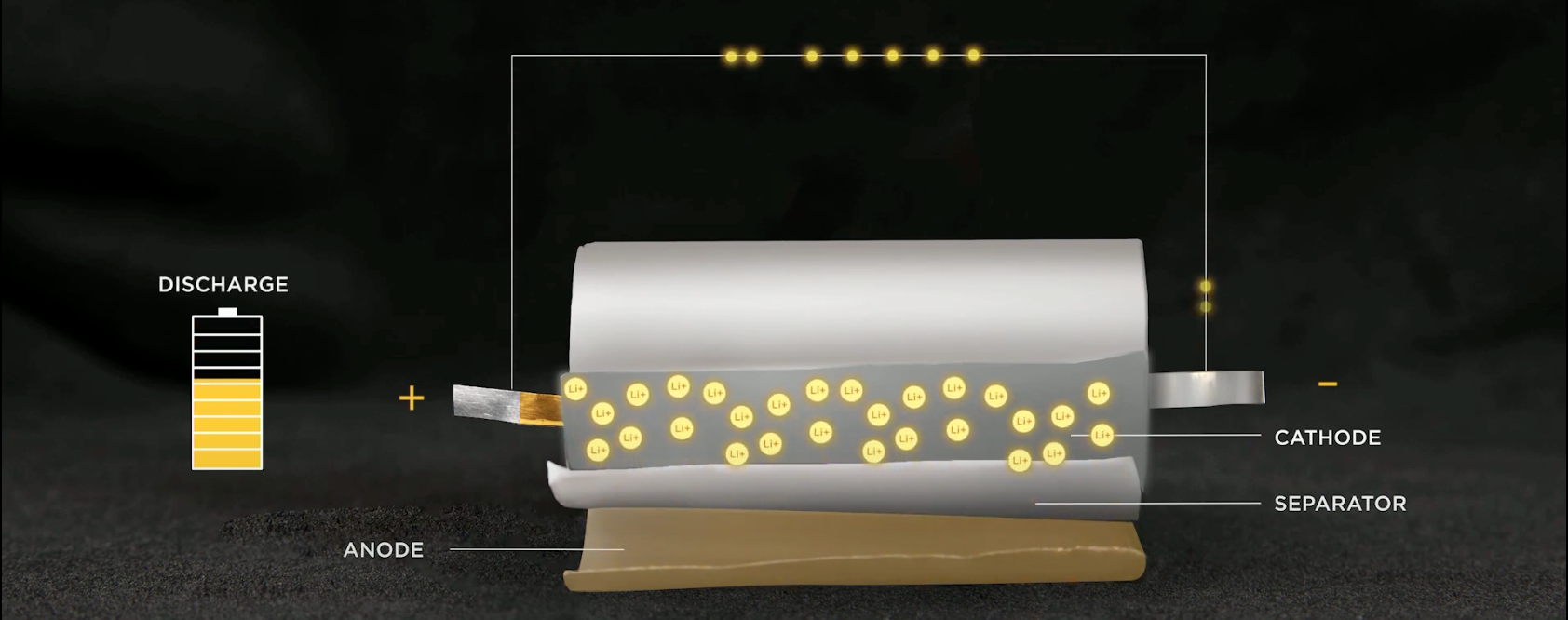Yesterday was quite an eventful day for Tesla fans and I have since taken the opportunity to record some notes in order to better understand everything that was discussed. As the day was broken up into two separate events this particular blog post will focus on the 2nd event known as Battery Day. Please continue reading below for a copy of my notes in blog format or if you prefer you can download a PDF version of the notes here. All of these notes were recorded based on the content discussed in the original video stream which can be found here.
Speakers
- Elon Musk
- Drew Baglino - SVP of Powertrain and Energy Engineering
Notes
We are experiencing serious issues with climate change and it is really important we accelerate the time to sustainable energy
- Last 5 years hottest on record
- We seemed to have hit a wall in regards to CO2 PPM
- “Running this climate experiment is insane” -Elon
The Trend is reversing but we need to accelerate it
- Wind & solar comprise 76% of new electric capacity this year (32GWh)
- Grid is converting to sustainable energy sources
- Estimated to take 25 years to make grid fully sustainable
46% of US power was generated by coal in 2010, now that number is half
Tesla’s Contributions to sustainable energy thus far
- 1M EVs delivered
- 26B EV miles driven
- 5 GWh of stationary batteries
- 17 TWh of Solar Generated
“To achieve the transition to sustainable energy, we must produce more affordable EVs and Energy Storage, while building factories faster and with far less investment"
Sustainable energy generation, storage, and electric vehicles are going to continue to be the biggest focus areas for Tesla
Goal #1 - Terawatt-hour scale battery production
- 100x growth in BEVs required in order to convert entire world fleet of vehicles
- In 2019 Tesla produced 0.006TWh (6GWh of batteries)
- Average vehicle life is 15 years so they are assuming they would need battery production to be 10TWh per year or 150TWh in total to do this
- “Tera is the new giga” -Elon
- 0.15TWh or 150GWh is the current production goal of Giga Nevada
- Current production is not enough, too much investment for too little result
- Would need 135 similar factories to hit 20TWh per year
- “Today’s batteries cannot scale fast enough, they’re just too small” -Elon
- 1600x growth required to rely on renewables for 100% of energy needs

- 100x growth in BEVs required in order to convert entire world fleet of vehicles
Goal #2 - More Affordable Cells
- Elon let it be known that their goal is still to produce a more affordable car but changes on battery development & manufacturing front need to be made first
- Curve of cell affordability is plateauing, not decreasing fast enough
- EV market share is growing however EVs still aren’t accessible to all
- Tesla’s philosophy - “To Make The Best Cars in the World, We Design Vehicles & Factories From The Ground Up”
- Now applying the same philosophy to batteries as well

Tesla’s plan is to halve the cost per KWh by focusing on several different areas:
- Cell Design
- Cell Factory
- Anode Materials
- Cathode Materials
- Cell Vehicle Integration
- NOTE: More elements of their plan will be made public at a later time
Cell Design (Results in 14% reduction in $ per kWh)
- Battery anatomy 101
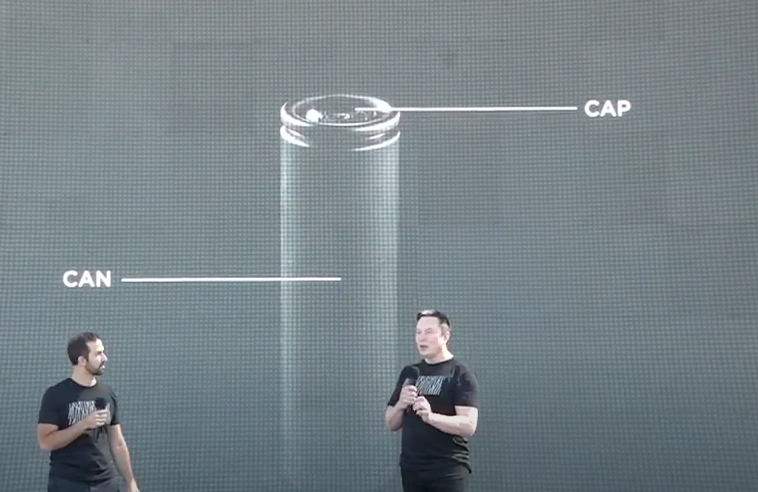
- Cap is positive terminal
- Can is negative terminal
- When you open cell you currently have a tab connected to those terminals which they refer to as the jelly roll
- Jelly roll is wound electrodes on the inside
- On a 2170 cell, the Jelly roll is almost a meter long per cell!
- What it looks like when they are discharging cells (Li+ flows from Anode to Cathode across separator)
- What it looks like when they are charging cells (Li+ flows from Cathode to Anode across separator)
- Tesla has continued to evolve their battery pack designs by leveraging 2170 cells where possible compared to the 18650 cells they originally leveraged (and still use in Model S & X)
- 18650 (aka 1865) dates back to ~2008 and has been improved upon with the 2170 cell design which has resulted in +50% energy
- First two digits refer to cell diameter
- Last two digits refer to cell length
- “When we look at the ideal cell design if we were to do it ourselves, we need to go beyond what we’re looking at what is in front of us and study the full spectrum of options” -Drew Baglino
- New Tabless Battery cell has been designed by Tesla
- “Any fool can make a bigger form factor” -Elon Musk
- Supercharging and cooling in general becomes a problem as you increase the battery cell size
- Tesla found a sweet spot of cell size around 46mm (diameter) that gives them the best charging speeds along with the simplest manufacturing process
- Also results in a 5x reduction in electric path length (50mm vs 250mm in 2170 cells today)
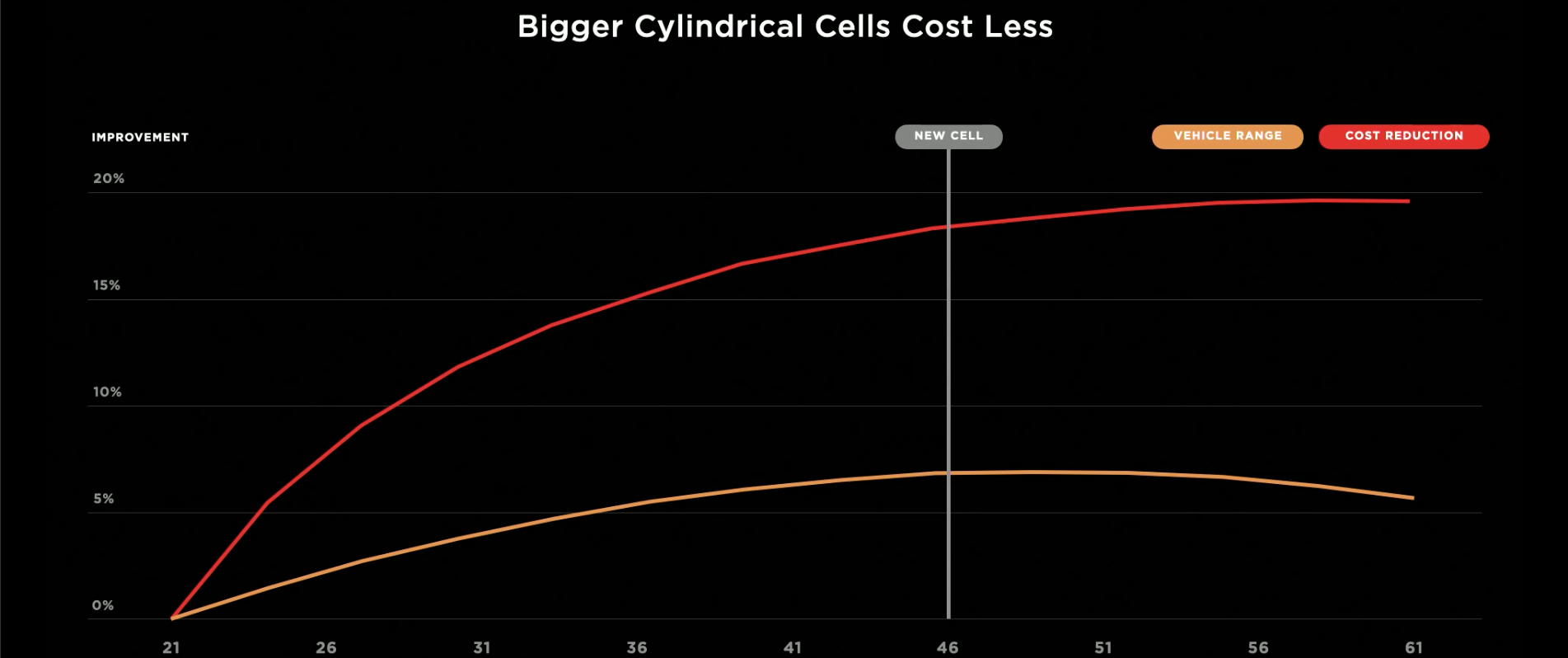
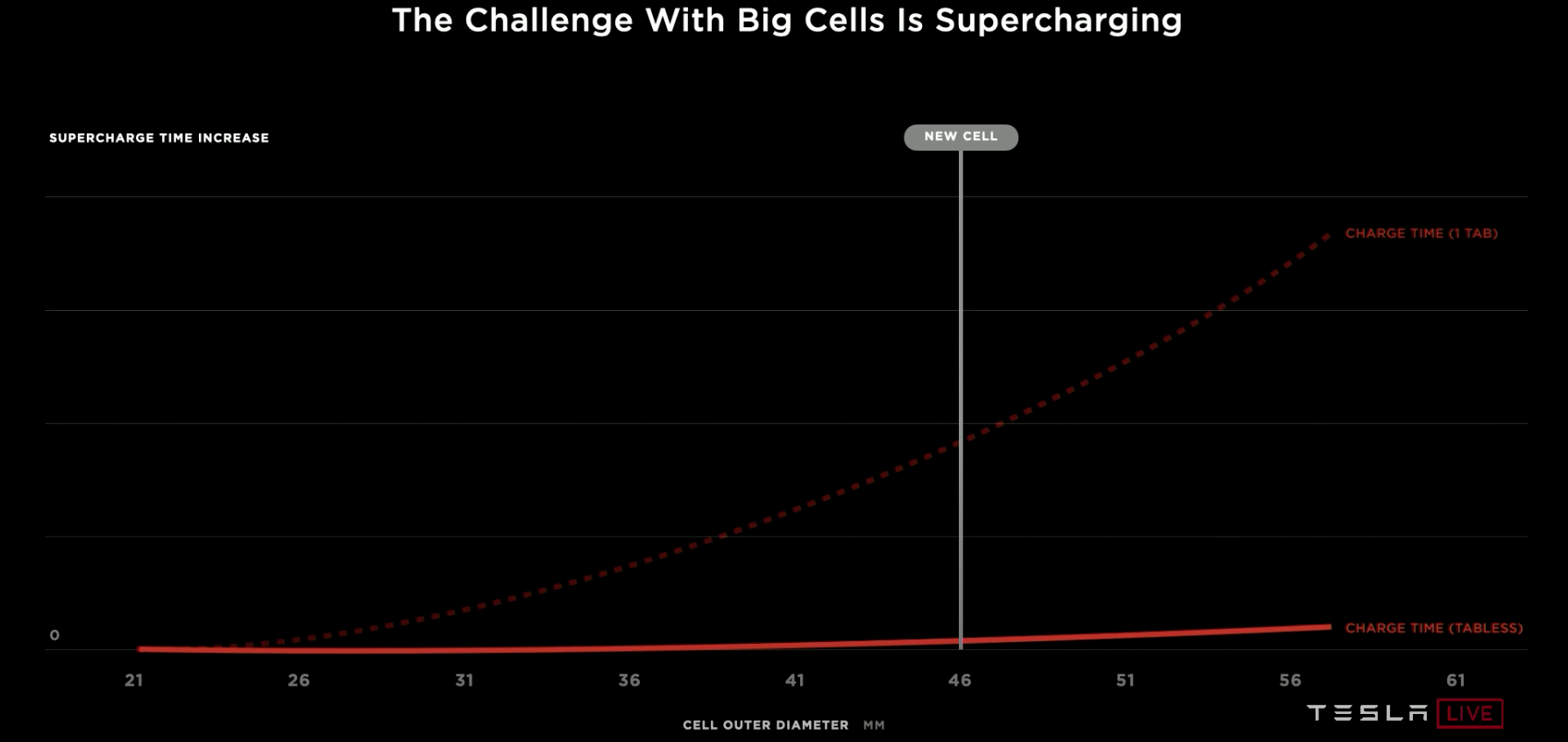
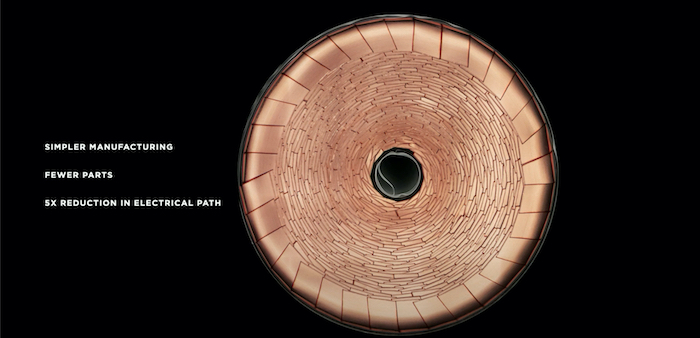
- To create the tabless design, Tesla took existing cell foils, laser powdered them, and enabled dozens of connections into the active material through the shingled spiral (see above)
- Power to weight ratio is better with the larger tabless cell than the existing, smaller 2170 cell with tabs
- “What’s elegant and simple is still hard” -Drew Baglino
- Ton of work went into this, “This is a massive breakthru” -Elon Musk
- Removal of tabs in cylindrical cells greatly simplifies winding and coating steps and greatly improves thermal & performance envelopes
- In current cell manufacturing, the system has to keep stopping where all the tabs are preventing continuous production (and lowering overall battery production)
- New cell is referred to as a 4680
- 46mm diameter, 80mm height
- 5x energy
- +16% range
- 6x power
- 14% reduction in $ per KWh at the pack level as a result of the new cell design
- NOTE: These increases are just related to just the cell design changes
- Starting to mass produce these cells at the Pilot Battery factory owned and operated by Tesla located on Kato Road in Fremont, CA
- Will take a year to reach this level of capacity (10GWh)
- The production version of the new battery factory is planned to produce 200GWh per year and more over time
- Note that they will not just have one of these battery factories but many around the world
- Battery anatomy 101
Cell Factory (Results in 18% reduction in $ per kWh)
- The Paper & bottling factories are Tesla’s inspiration for how they want to improve battery manufacturing
- Li+ industry has so far to go (only in 3rd decade of production)
- What’s in a Cell Factory

- Electrode process - Where active materials are coated into films onto foils
- Winding process - Where coated foils are wound
- Assembly process - Where the jellyroll (aka wound electrodes on the inside) is assembled into the can, filled with electrolyte, and sealed
- Formation process - Where cell is charged for the first time, electrochemistry is set and the q uality of the cell is validated
- Tesla has focused on improving battery manufacturing at the factory level by focusing on the following process steps of cell production:
- Electrode Process
- Currently the industry utilizes a as the wet process
- Mixing (powders are mixed with waters or solvent (for cathode))
- Mix goes into a large coat & dry oven where the slurry is coated onto the foil (huge ovens, 10s of meters long)
- Dried and solvent recovered
- Foil compressed to finally density
- Lots of space needed currently during the wet process, notice how 1 person is on the left to show the scale of equipment needed

- Current solvent recovery process involves essentially digging a ditch, putting the solvent in and take it out & recycle it
- Tesla sought to simplify this process by moving to a dry process which involves skipping the solvent recovery step (and going straight to dry mix and then to coating)
- In their demo video they show how they can now take dry powder and form it directly into film
- “It’s actually very hard to do what appears to be a simple thing” -Elon
- Elon cited Maxwell acquisition & how they had a dry process of their own however it was more of a proof of concept
- Since the acquisition Tesla has created 4 revisions of their dry process (and subsequent pilot production line) and continues to work towards a volume production-ready version of this process
- The end result of this work will be a greatly simplified battery manufacturing process, increased production, along with a dramatic reduction in both cost (10x) & footprint (10x) required to produce batteries at scale

- Current version of the process is currently generating moderate yields however still needs quite a bit of improvement in order to achieve volume production-ready yields
- Currently made 10s of thousands of cells
- They should be able to reach volume production by version 6 or 7 of their process & production line
- Their current rate of innovation is a new revision every 3-4 months
- Assembly Process
- High-speed continuous motion assembly is the ultimate goal in this step i.e. you want a highway that requires no stopping along the way
- The concept Tesla followed here was a highway operating at maximum velocity, no city driving
- Tesla as a result developed the appropriate manufacturing equipment that could operate at a high velocity and result in a constant battery production highway with no stops along the way
- This equipment was used to form a single assembly line that is capable of :
- 20GWh
- 7x output per line
- Elon referenced how inefficient a typical factory (~2-3%) is from a perspective of useful space and referred to Tesla’s factory in Fremont as one example
- He believes it is possible to get to a 10x more efficient factory (>=30% volumetric efficiency) which translates to a 10x smaller facility
- This efficiency will allow Tesla to produce more with less which is a huge advantage from them (and one that will differentiate them vs their competitors)
- This will all be achieved through Tesla’s vertical integration thanks to their acquisitions of Grohmann Automation & Hibar Systems
- “Tesla is aiming to be the best at manufacturing of any company on earth” -Elon Musk
- Formation Process
- In a typical cell factory, formation is roughly 25% of the overall factory investment
- What is the formation process? It is where cells are charged & discharged and where quality of the cell is verified

- This is an image showing where cells are individually charged & discharged during the formation process
- Tesla took their knowledge from developing their principal and power electronics (including Powerwall, vehicle battery management systems, etc) to create new & dramatically improved formation equipment which resulted in:
- 86% reduction in formation investment
- 75% reduction in formation footprint
- New cell manufacturing facility design results in:
- 75% reduction investment per GWh
- 4x better than the latest state of the art tech produced by the rest of the battery industry
- More room to improve going forward
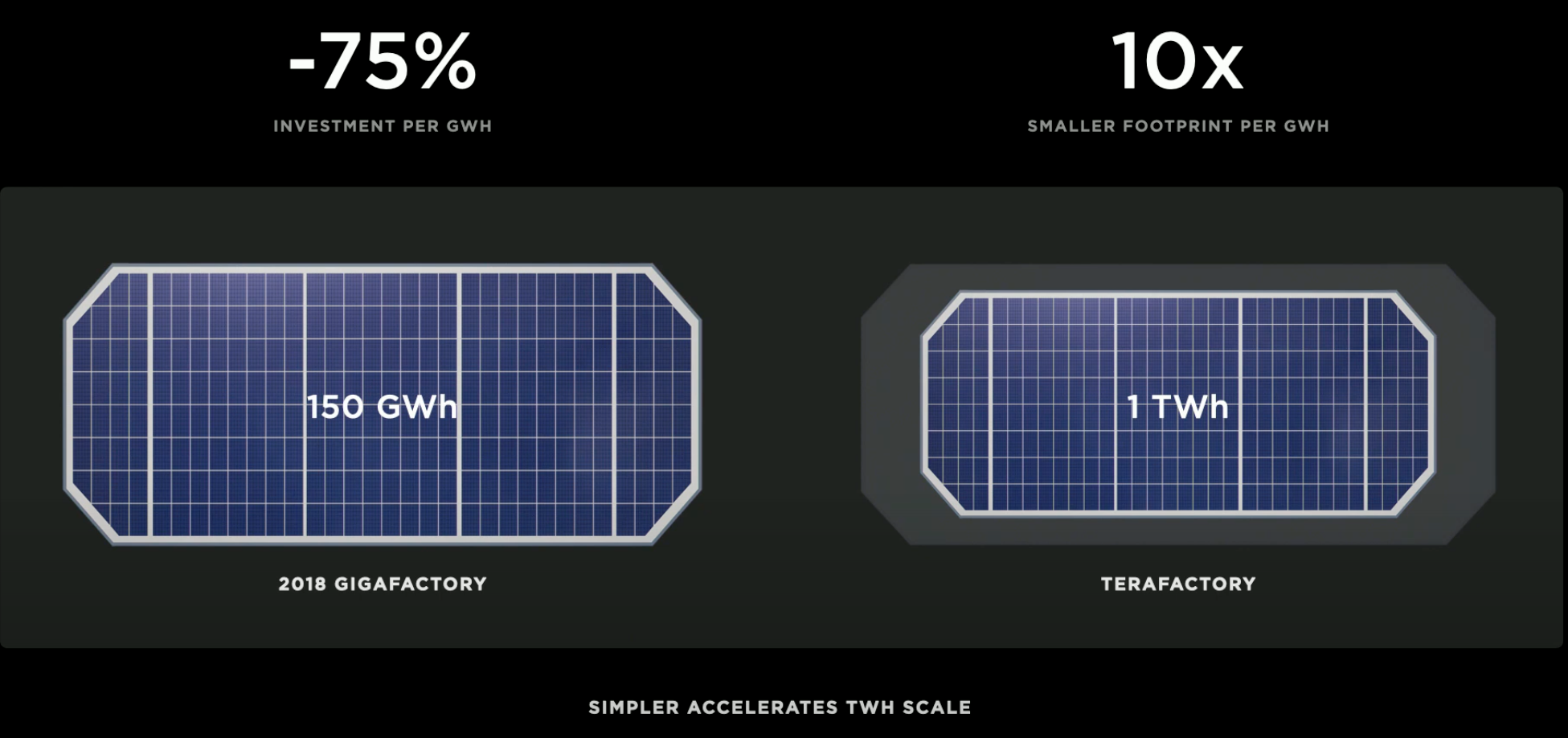
- When designing a factory with these new process enhancements in mind, Tesla can now create a facility that can produce ~7x more battery cells all within a smaller footprint than their existing Giga Nevada factory
- All of the factory & production-related advancements result in a further 18% reduction in $ per KWh at the battery pack level
- The plan going forward is to:
- Produce 100GWh per year worth of battery cells in-house by 2022
- Produce 3TWh per year worth of battery cells in-house by 2030
- Elon believes Tesla can achieve this goal before 2030
- Continue to leverage existing partners like CATL, LG, and Panasonic so they can continue to scale to meet the increasing demand for EVs and Energy products
- Currently the industry utilizes a as the wet process
- Electrode Process
Anode Materials (Results in a 5% reduction in $ per KWh)
- Silicon is awesome because:
- It is the most abundant element in earth’s crust after oxygen (everywhere aka sand)
- Stores 9x more Lithium than graphite which is the material typically used for the anode in a Li+ battery
- The reason why nobody else is using silicon in batteries is due to the fact it expands by 4x when charged with Lithium which results in:
- Particles begin to crack
- Electrical isolation
- Energy capacity and retention degrades
- Silicon gums up with a passivation layer which has to keep reforming as the particles expand
- “Basically with Silicon the cookie crumbles and gets gooey"
- Silicon is used in current Tesla battery tech however requires highly engineered & expensive materials
- These enable some of the benefits of Silicon but not all of them
- Limit scalability to engineering & cost overhead
- Anode Material Cost Comparison
- Silicon structured in SIO Glass for Anode - 6.6 $ per KWh
- Silicon structured in Graphite for Anode - 10.2 $ per KWh
- Silicon nanowires for Anode - >100 per KWh
- Tesla Silicon - 1.2 $ per KWh
- Tesla Silicon on the other hand will result in more capabilities at a lower cost
- Instead of engineering base metal just leverage raw silicon in manufacturing
- Account for the Silicon’s expansion during the design process
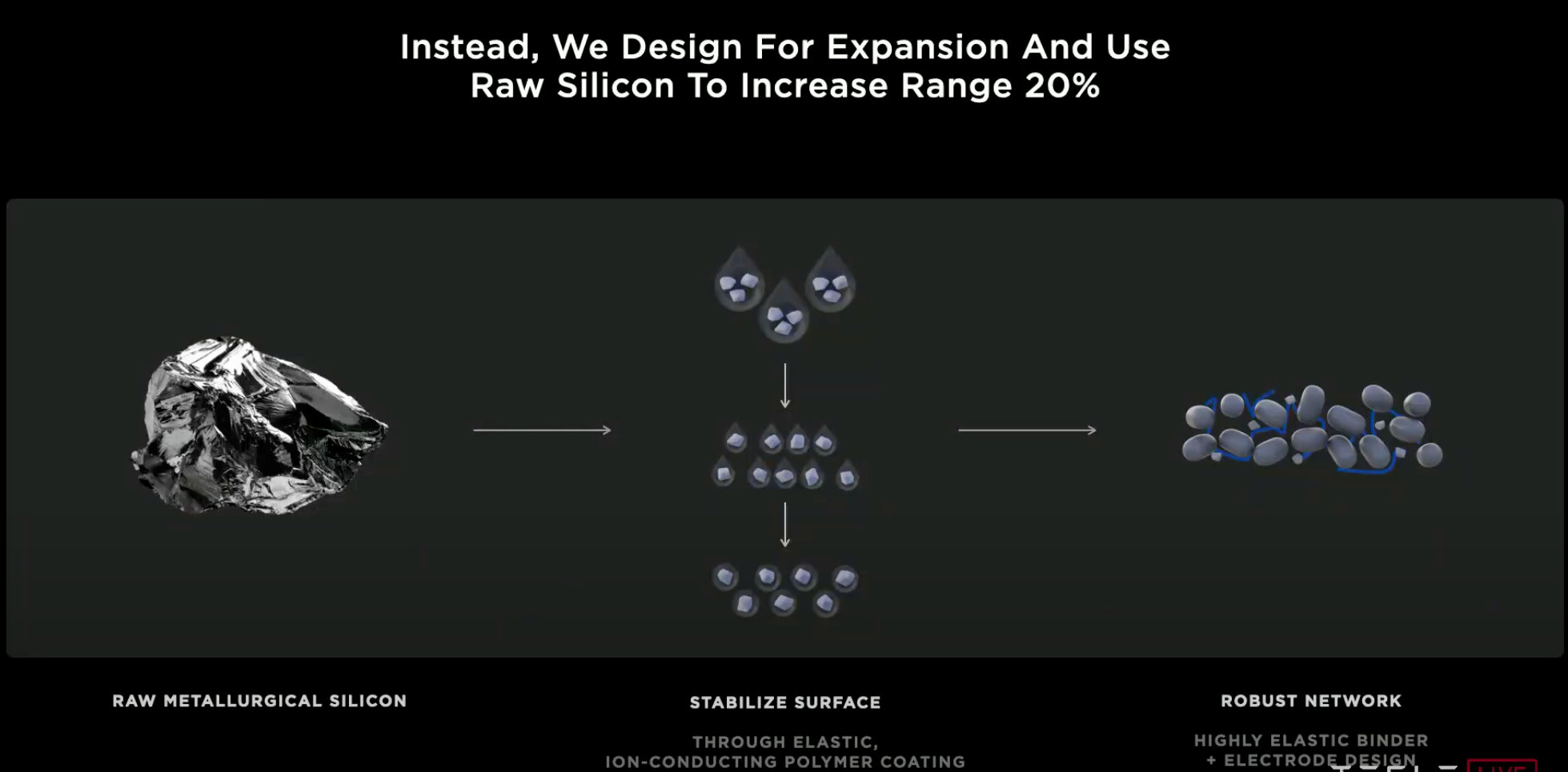
- Range can be increased by 20% and the overall $ per KWh is reduced by 5% from this improvement alone
- Silicon is awesome because:
Cathode Materials (Results in a 12% reduction in $ per KWh)
- What is as battery cathode? A cathode is like a bookshelf where the metal (aluminum, cobalt, iron, manganese, or nickel) is the shelf and the lithium is the book
- The metals are different in that some offer a greater number of lithium “books” to be stored and provide a sturdier “shelf”

- These more effective metals like Cobalt can be expensive and translate to higher battery prices like the ones we see today
- The idea here is that you need to have stable structure to contain the ions and one that that holds its shape in both the anode & cathode as you are moving ions back & forth
- If you fail at this part of the equation you will lose battery cycle life and overall capacity drops significantly
- Cobalt is used now as it is a very stable “bookshelf” however has the highest cost
- Nickel is a great alternative to Cobalt as it has a higher energy density at half the cost per KWh
- The current challenge with going pure Nickel is that requires additional stabilization in order for it to provide an equally stable “bookshelf"
- Tesla as a result has been working on High Nickel Cathode Development which allows them to:
- Maximize Nickel and completely remove Cobalt by using novel coatings and dopants
- A dopant is defined as as, “A substance used to produce a desired electrical characteristic in a semiconductor”
- Recognize a 15% reduction in cathode $ per KWh
- Maximize Nickel and completely remove Cobalt by using novel coatings and dopants
- In order to continue scale Nickel availability needs to increase as well however to ensure that doesn’t hinder Tesla’s growth they are taking a tiered approach to metals used in the cathode
- Medium Range / Low Energy Density -> Iron
- While Nickel provides 2x the energy density over Iron at the cathode level, when you consider everything at the pack level the difference shrinks to about ~1.5x
- Long Range / Medium Energy Density -> Nickel + Manganese
- The cathode would be comprised of 2/3 Nickel and 1/3 Manganese
- Would allow Tesla to make 50% more cells with the same amount of Nickel
- Very little energy trade off compared to High Nickel
- Mass Sensitive / High Energy Density -> High Nickel
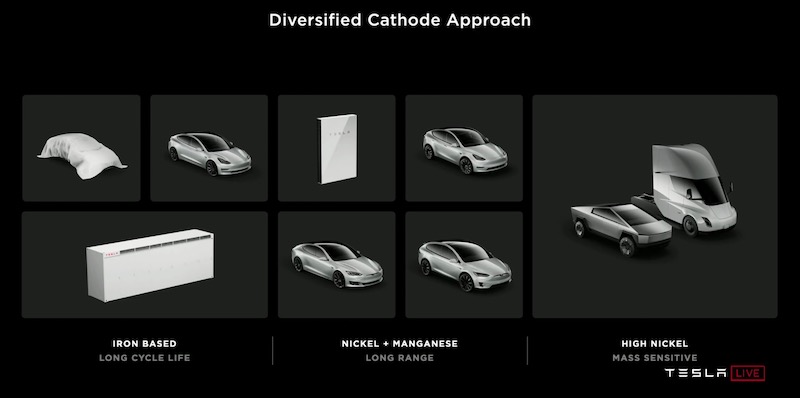
- Aside from the metals themselves the cathode manufacturing process has been a big target for Tesla
- 35% of the total $ per KWh figure for cathode cost is tied to processing & transferring it into its final form
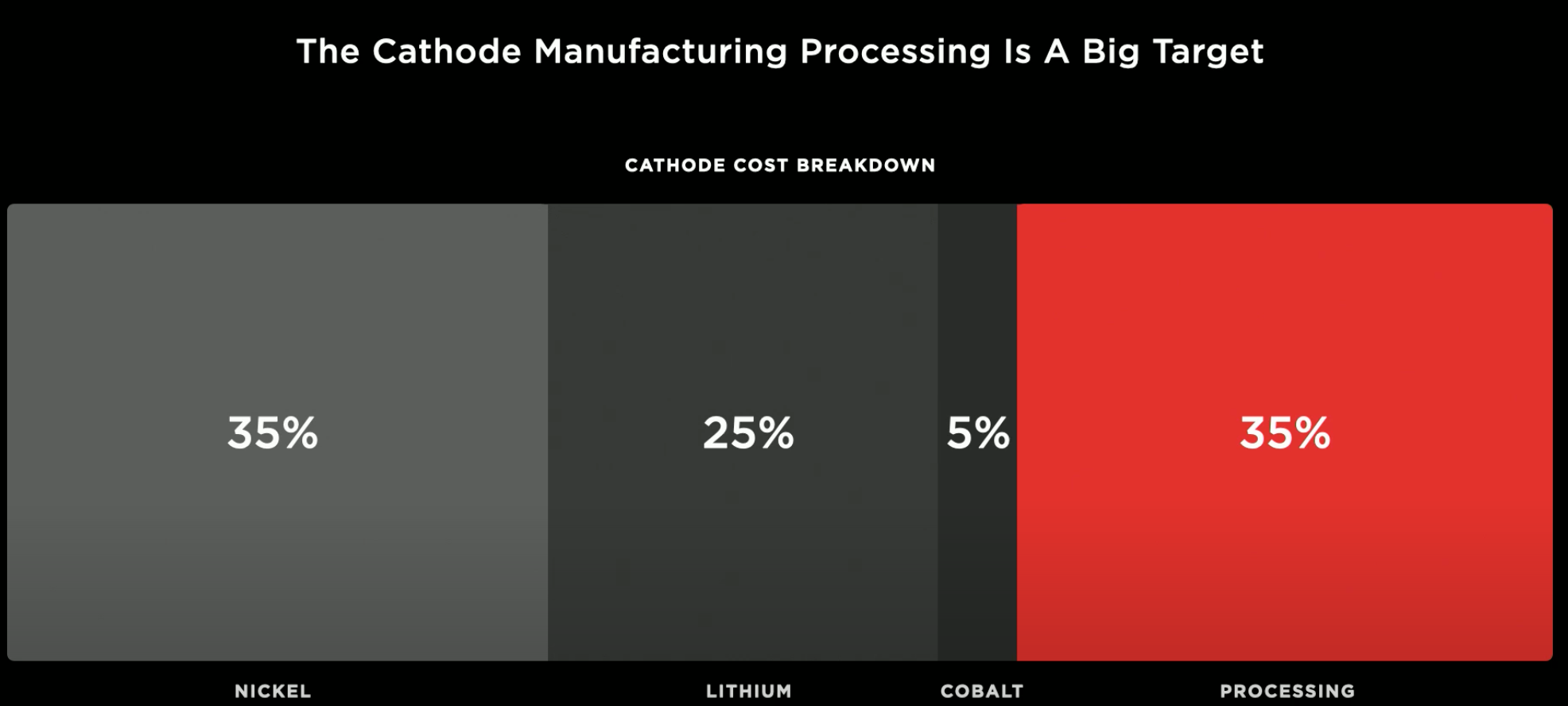
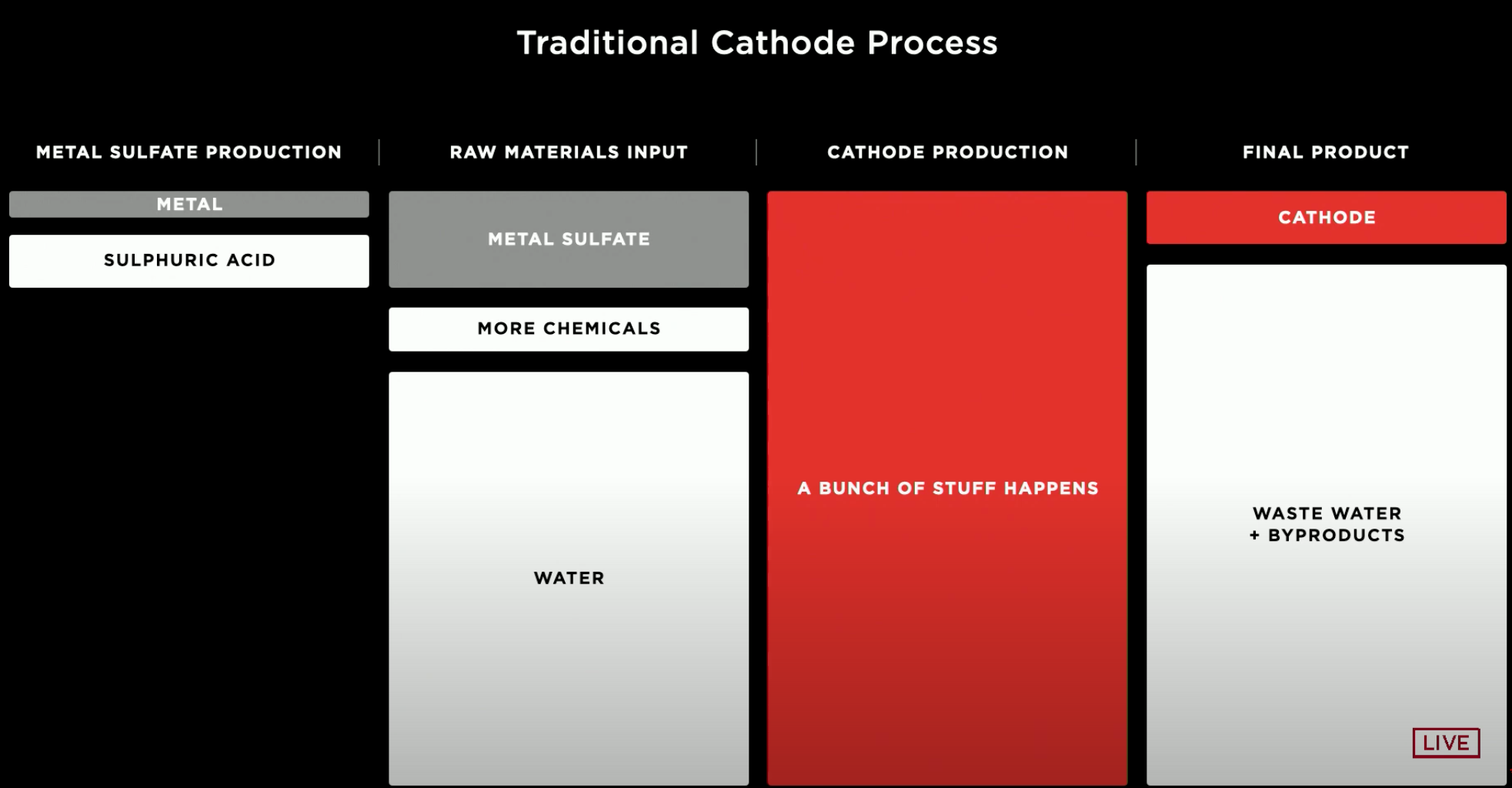
- The current process is overly complicated and has never been examined from a first principles perspective
- Tesla has been working on simplifying this process and has come up with their own streamlined process

- No more metal or waste water
- Less chemicals
- Less water consumed as they can now recirculate & re-use it
- Simplify overall process as a result
- 66% reduction in CAPEX investment
- 76% reduction in overall process cost
- More scalable as a result
- Because their process is able to consume the raw Nickel powder, it dramatically simplifies the metal refining step of the entire process
- This reduces the need for battery-grade nickel production by billions
- As a result they can also reuse Nickel coming out of recycled EVs & grid batteries
- Tesla will also greatly reduce costs of cathode production by limiting the distance mined materials have to travel in order to be processed (distance traveled of mined resources reduced by up to 80%)
- Cathode production will occur in the same Tesla cell production plant
- Mined materials will go straight from mine to this production plant and be transformed into functional battery cells
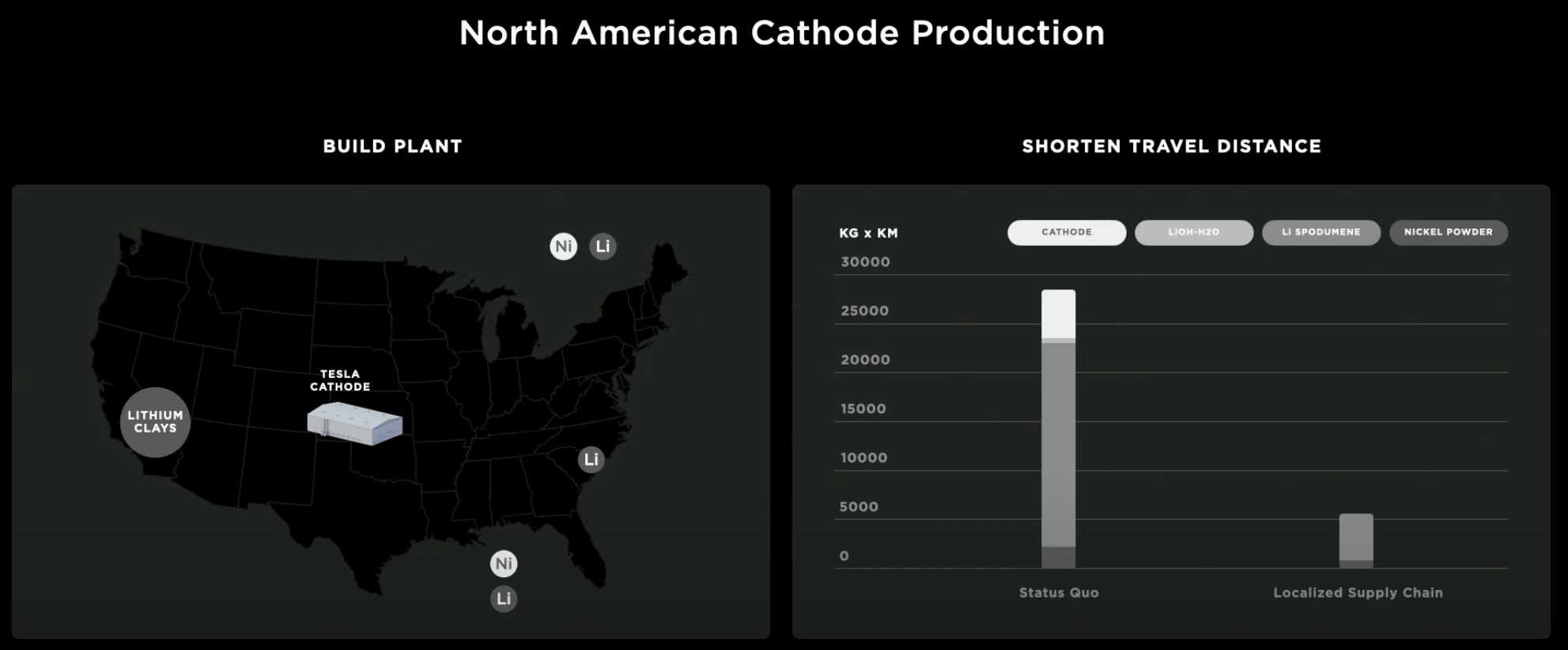
- On top of this, since Lithium enters the cell through the cathode, it also makes sense for Tesla to process Lithium at this same facility as well
- Processing Lithium at the same site results in a:
- Sulfate-free process
- 33% reduction in Lithium costs
- 100% electric facility that could be 100% powered by renewables
- Lithium is pretty much everywhere and much more abundant than oil
- Nevada alone has enough discovered Lithium to convert the entire automotive fleet of the US to BEVs
- Lithium discovery is in its infancy and there is more Lithium out there that has yet to be discovered
- Tesla wanted to also simplify Lithium extraction and make it more environmentally friendly & scalable
- Tesla as a result discovered a method to extract lithium from ore using simple table salt (sodium chloride)
- Never been done by anybody before
- All elements are reusable
- Environmentally friendly & sustainable
- Tesla has secured the rights to a 10k acre lithium clay deposit in Nevada
- The mining process involves removing the clay from the ground, extracting the Lithium and putting the clay back where they found it
- At the point where Tesla achieves 20TWh of battery production per year, they believe no more additional mining will be required as they will be able to recycle old batteries to produce new ones

- Tesla already recycles 100% of their vehicle batteries today
- They are also starting their pilot full scale recycling production at Giga Nevada in Q4 2020
- To date it has been done by 3rd parties
- Tesla believes they can do a better job recycling than the 3rd party and do it sooner as recyclers usually lag behind by 10 years
- Medium Range / Low Energy Density -> Iron
Cell Vehicle Integration (Results in a 7% reduction in $ per KWh)
- Elon believes using a casting process will be the way all EVs are produced in the future
- Tesla’s effort in regards to casting started with attempting to create a single piece casting for the front underbody and another piece for the rear underbody of the Model Y
- They have since commissioned the largest casting machine ever made located over at the Fremont factory
- 40% rear underbody cost savings
- -79 parts per car
- In order to do this Tesla had to develop their own alloy of aluminum in order to have required strength, be compatible with the casting process, and to not require heat treatments or coatings
- Tesla materials team continues to be a differentiator for the company and I no doubt believe some of the expertise is being shared by SpaceX
- Additional new alloys along with other materials never existed before are coming soon as well
- In Tesla’s plan, the single front underbody piece would be joined with the rear underbody piece by way of the structural battery
- The battery will be both an energy and a structural device
- You can compare this to how airplane wings work where the fuel tanks are placed inside the wings
- “Fuel tank in wing shape” -Elon Musk
- “Tesla is doing the same for cars” -Elon Musk

- With current battery packs in use today, the non-battery cell areas of the pack have “negative mass” and take up valuable space &
- Tesla’s structured battery design results in additional mass savings for the vehicle along with more densely packed cells
- This is a result of removing supports, stabilizers, stringers and structural elements
- Allows the cells to also be organized more towards the center of the pack which reduces the probability of a side impact reaching the cells
- The filler material currently is just flame retardant however in the future it also include structural adhesives
- Structural adhesive glues the cells to the top and bottom steel sheets that make up the structural battery
- This configuration results in a structure that is stiffer than any regular car out there
- As an example, a convertible with this structured battery would be stiffer and more rigid than a regular car
- Overall the casted body pieces + structural battery result in:
- 10% reduction in mass
- Up to 14% increase in range
- 370 fewer parts
- Massive simplification on the factory side of things
- 55% reduction in factory investment per GWh
- 35% reduction in factory floorspace
- 7% reduction in $ per KWh
Taking it all in from a vertical integration perspective
- Through cell design, anode material + process, cathode material + process, and cell vehicle integration advancements, Tesla will be able to:
- Increase vehicle range by 54%
- Reduce the $ per KWh by 56%
- Reduce the manufacturing investment per GWh by 69%
- Tesla will start realizing these advancements and take approximately 3 years to fully realize them across their product lines
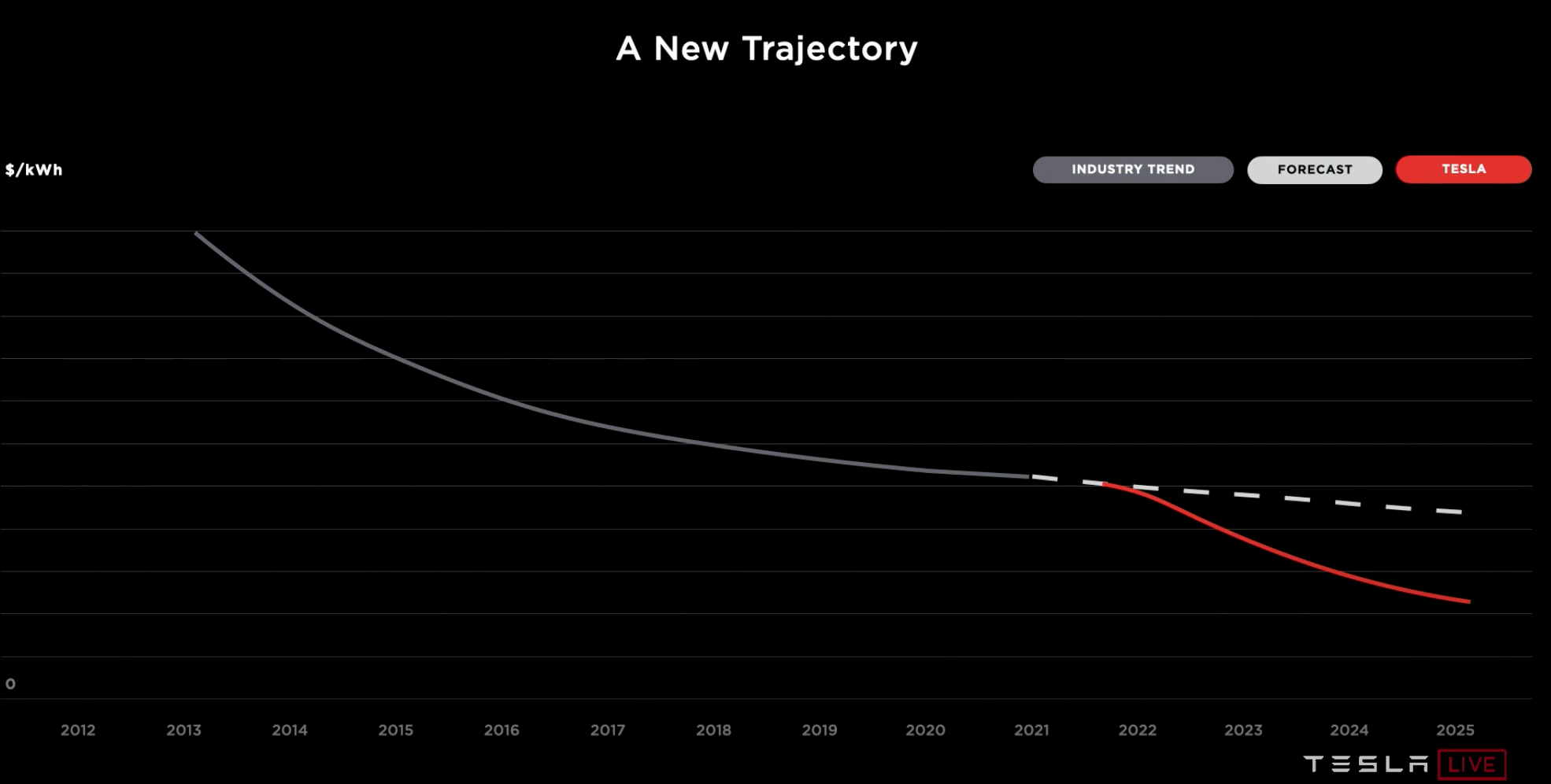
- Elon’s long term goal for Tesla is to replace 1% of the global vehicle fleet which is about 2 billion vehicles
- This equates to a production rate of 20M vehicles per year
- Through cell design, anode material + process, cathode material + process, and cell vehicle integration advancements, Tesla will be able to:
Future Products
- Entry level EV
- Based on these new advancements, Elon is confident they will be able to produce a compelling EV at a price point of $25k within the next 3 years
- This vehicle would be fully autonomous as well
- Model S Plaid
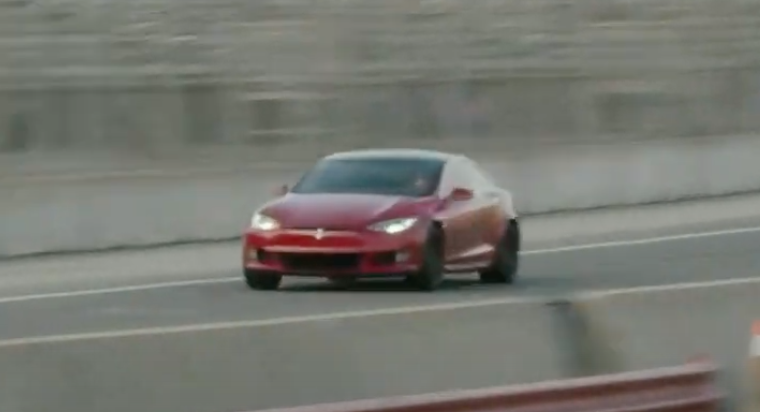
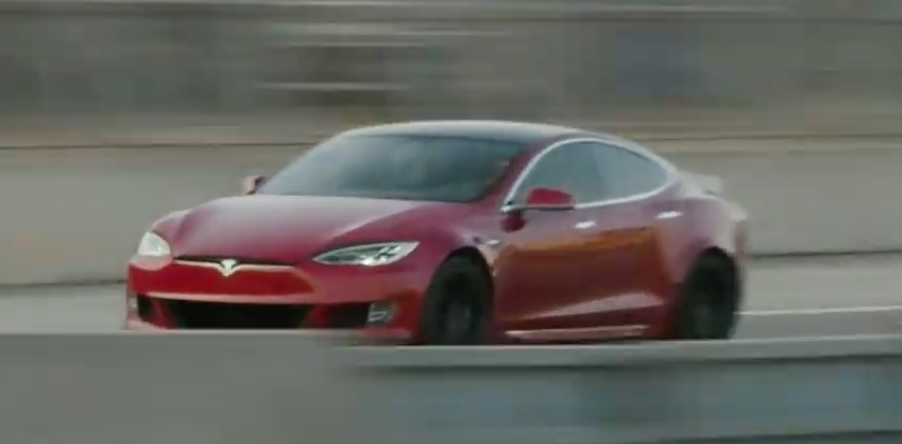
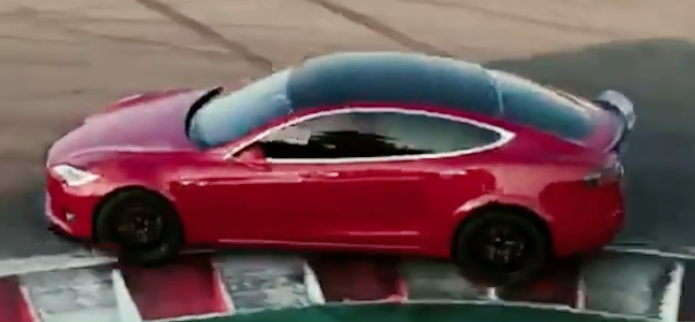
- <0-60 <2s
- <9 sec 1/4 mile
- 200mph top speed
1100hp
520mi range
- 1:30.3 lap-time around Laguna Seca with ~3 more seconds to give with a more mature setup and testing
- Last minute test done last Sunday, September 20th, 2020
- Goal is for the Plaid Model S to be the fastest production car around Laguna Seca ever, ICE or EV
- Available late 2021
- Entry level EV

